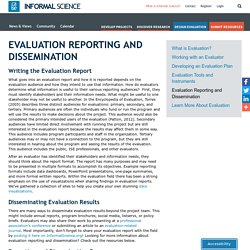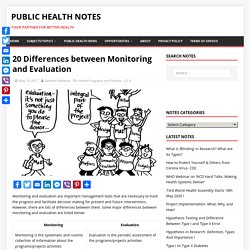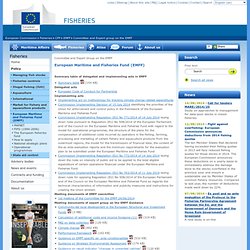

Evaluation Reporting and Dissemination. Writing the Evaluation Report What goes into an evaluation report and how it is reported depends on the evaluation audience and how they intend to use that information.

How do evaluators determine what information is useful to their various reporting audiences? First, they must identify stakeholders and their information needs. What might be useful to one stakeholder may not be useful to another. In the Encyclopedia of Evaluation, Torres (2005) describes three distinct audiences for evaluations: primary, secondary, and tertiary.
After an evaluator has identified their stakeholders and information needs, they should think about the report format. Disseminating Evaluation Results There are many ways to disseminate evaluation results beyond the project team. Reporting and Dissemination Resources Reporting and Dissemination: Building in Dissemination from the Start. Home - DataVisualizationandReporting. How to Write a Program Evaluation Report (Guide) - Report Format/Template. A clear, concise, brief and yet complete guide on writing mid-term or final evaluation report for a Project of any kind.

The format is also available in MS Word format and can be downloaded from here: Evaluation Report Writing Template. 1. Executive Summary. EU Orphan Regulation evaluation; meeting unmet need and facilitating access. EFPIA notes the publication of the Study to support the evaluation of the EU Orphan Regulation (Technopolis, July 2020).

The report “finds that the EU Orphan Regulation has contributed to important strides in the field of rare diseases and development of orphan medicines. Since the Regulation was introduced more products have come on the market. There is also a promising pipeline of products under development, that may bring real value to patients for whom currently no treatment options exist.”[1]EFPIA believes that the evidence in the report supports keeping the existing legislation on orphan medicines in place, while underlining the need to co-create vehicles to drive research to areas of unmet medical need and address issues around access to new treatments.
EFPIA Director General, Nathalie Moll said. Nathalie Moll continued. Common Risks Identified in Global Fund Programmes. Evaluation methods. Choosing methods for evaluation A wide variety of research methods and data collection tools are available for use in evaluation: qualitative and quantitative.

Different methods are suitable for answering different types of evaluation questions. This section provides an overview of the most common methods. The resources referred to at the end of this section give more detail on different methods and how to use them. Qualitative research Introduction to qualitative research Qualitative research encompasses a variety of methods, but is often defined in terms of using words and text in data collection and analysis, rather than using numerical measurement and quantification (Bryman, 2016).
Qualitative research is usually ‘bottom up’ rather than ‘top down’. Qualitative research is not concerned with representing a population, in the way that quantitative research is, but with investigating topics in depth (Willig, 2008). Benefits of qualitative research. How to Write a Program Evaluation Report (Guide) - Report Format/Template. 20 Differences between Monitoring and Evaluation - Public Health Notes. Monitoring and evaluation are important management tools that are necessary to track the progress and facilitate decision making for present and future interventions.

However, there are lots of differences between them. (4) difference between monitoring and evaluation. Soodi Milanlouei. OKR: Home. Guidance - Regional Policy. The European Commission has suggested a more results – oriented approach for EU cohesion funding in its legislative proposals for 2014 - 2020.

Evaluating EU cohesion policy Guidance Documents for the 2014 – 2020 funding period Impact evaluation centre In any programme, the crucial questions are "what do you want to change? " and "how would you know if you have changed it? " Impact evaluation in DG Regional Policy falls into two broad categories: The "Theory-based" impact approach, which follows each step of the intervention logic and focuses on the mechanisms leading to the observed change, is particularly appropriate for answering the questions "why? " The two approaches are complementary and the most useful impact evaluations draw on a mix of methods: counterfactual methods to quantitatively estimate an impact, theory-based methods to understand the underlying mechanisms and the context of an intervention thus helping to modify or generalize it to other contexts. Conterfactual approach.
Committee and Expert Group on the EMFF - Fisheries. European Commission Fisheries Accessibility tools Go to content Service tools Language selector Current language English (en) Navigation path Fisheries Search Free text Search all news News Study on approaches to management for data-poor stocks in mixed fisheries The ten Member States that declared having exceeded their fishing quotas in 2013 will face reduced fishing quotas for those stocks in 2014.

A new study is on-line. Home page - Evaluations - Research.
What Works Centre for Local Economic Growth.